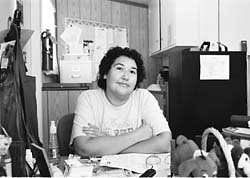Dragon Info Head Start From Preschool to Crisis Intervention  Dealing with Challenging Kids  MAAC Staff    First Start 
|
Dealing with Challenging Kids October 2002
MAAC Head Start teachers deal with kids that run the gamut from model kids to children who suffer from all the ills and dysfunctional problems of society. After several crisis situations in the mid-1990s [see accompanying story], they have developed a wide range of procedures to help get children and families back on track. When a child’s problem is beyond the teachers’ resources, the agency contracts with mental health crisis professionals who come in and provide extra services and training to the staff. One of the biggest hurdles is getting parents who are in denial to accept the fact that their children have problems and to deal with them. Often the teachers ask the parents to come and observe the child from a distance; other times they videotape the child acting out and show the videotape to the parents. The problems range from children who act out with violent behavior to children with learning disorders. The agency evaluates the children and then makes referrals for the parents to get the appropriate services. The next hurdle is to get the parents to follow through. Head Start teacher Vickie Schlater describes some of the children she works with: “When we have children with special needs and we can’t handle them, it becomes a community effort. I had a child last year who would hit other children, and it was hard for us to deal with it. We called the administration and told them we needed help in the classroom. I needed some ideas on how to deal with this child. So they sent out a crisis intervention counselor. She came out and worked with the child one-on-one. She shadowed the child, following the child to make sure he didn’t harm any of the other children or teaching staff and to observe his behavior. “She gave me some ideas about what I could do with him and how to work with him. She suggested that with a child like that, if we made Play-Doh he could play by himself and that would stimulate him. It worked. He would sit there for a half hour and not bother any of the other children. I was really taken by that.” Teaching Kids to Use Words to Get What They Want “She also pointed out that as she observed him with other children, they would say something to upset him or tease him, and that is when he would hit them. Often kids get violent because they are frustrated that they can’t communicate what they are feeling or answer back. Instead of saying, ‘Please don’t do that,’ they hit. “One of the main things we do is to teach the kids to use words to get what they want. If they can’t use the words, we get them to point and then teach them to say they want the ball rather than take it from the other child. So we teach kids to use words to express to the teachers or other children what is bothering them,” Schlater states.
|
||||||

